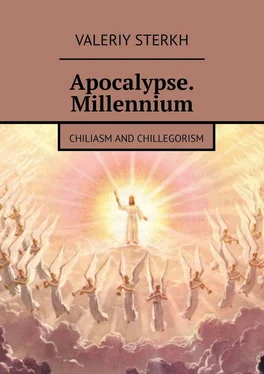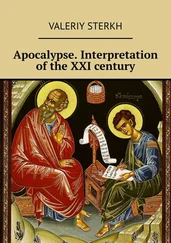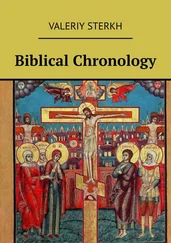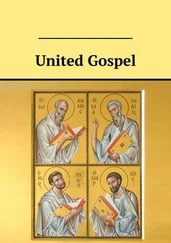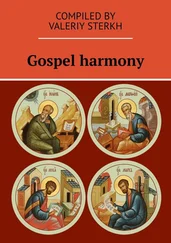Valeriy Sterkh - Apocalypse. Millennium. Chiliasm and Chillegorism
Здесь есть возможность читать онлайн «Valeriy Sterkh - Apocalypse. Millennium. Chiliasm and Chillegorism» — ознакомительный отрывок электронной книги совершенно бесплатно, а после прочтения отрывка купить полную версию. В некоторых случаях можно слушать аудио, скачать через торрент в формате fb2 и присутствует краткое содержание. ISBN: , Жанр: Религиозная литература, Критика, Публицистика, Религиоведение, на английском языке. Описание произведения, (предисловие) а так же отзывы посетителей доступны на портале библиотеки ЛибКат.
- Название:Apocalypse. Millennium. Chiliasm and Chillegorism
- Автор:
- Жанр:
- Год:неизвестен
- ISBN:9785449871831
- Рейтинг книги:4 / 5. Голосов: 1
-
Избранное:Добавить в избранное
- Отзывы:
-
Ваша оценка:
- 80
- 1
- 2
- 3
- 4
- 5
Apocalypse. Millennium. Chiliasm and Chillegorism: краткое содержание, описание и аннотация
Предлагаем к чтению аннотацию, описание, краткое содержание или предисловие (зависит от того, что написал сам автор книги «Apocalypse. Millennium. Chiliasm and Chillegorism»). Если вы не нашли необходимую информацию о книге — напишите в комментариях, мы постараемся отыскать её.
Apocalypse. Millennium. Chiliasm and Chillegorism — читать онлайн ознакомительный отрывок
Ниже представлен текст книги, разбитый по страницам. Система сохранения места последней прочитанной страницы, позволяет с удобством читать онлайн бесплатно книгу «Apocalypse. Millennium. Chiliasm and Chillegorism», без необходимости каждый раз заново искать на чём Вы остановились. Поставьте закладку, и сможете в любой момент перейти на страницу, на которой закончили чтение.
Интервал:
Закладка:
PS1. In modern theology, there is a tradition of using the term “Chiliasm” or “Millennialism” mainly in relation to the teachings that imply a literal interpretation of Rev 20:1—4. We will retain the same terminology here to avoid confusion. Also, a new term “Chillegorism” (i.e. “allegorical Chiliasm”) is introduced as a general concept of Postmillenarism and Amillenarism.
PS2. Some authors writing on the topic use these terms incorrectly, often confusing them with each other (especially “Postmillenarism” and “Amillenarism”). However, if the reader knows the proper meaning of these terms, such errors are fairly easy to spot. So, in the citations below, we retain the terminology “as is”.
Some will say that “the fundamental difference between Postmillennialism [Postmillenarism] and Amillennialism [Amillenarism] is not entirely clear” (Nikolay Kim, a priest, The Millennial Kingdom. Exegesis and the History of Interpreting the 20th Chapter of the Apocalypse . St. Petersburg, 2003, p. 28), or that “the term ‘Amillennialism’ [‘Amillenarism’] is not a happy one” (Anthony A. Hoekema Amillennialism //The Meaning of the Millennium, 1977; see also Jay E. Adams, The Time Is at Hand , Philadelphia: Presbyterian and Reformed Publishing Co., 1970. pp.7—11). The real reason for such confusion lies in the incorrect definition and use of the above terms.
PS3. There are other types of chiliastic and chilleagorical doctrines (Adventism, Jehovah’s Witnesses [their activities are banned or restricted in some countries], Dispensationalism, Communism, etc.). Most of them are speculative, heretical or non-Christian in their nature. A detailed analysis of these teachings is not in the scope of this book.
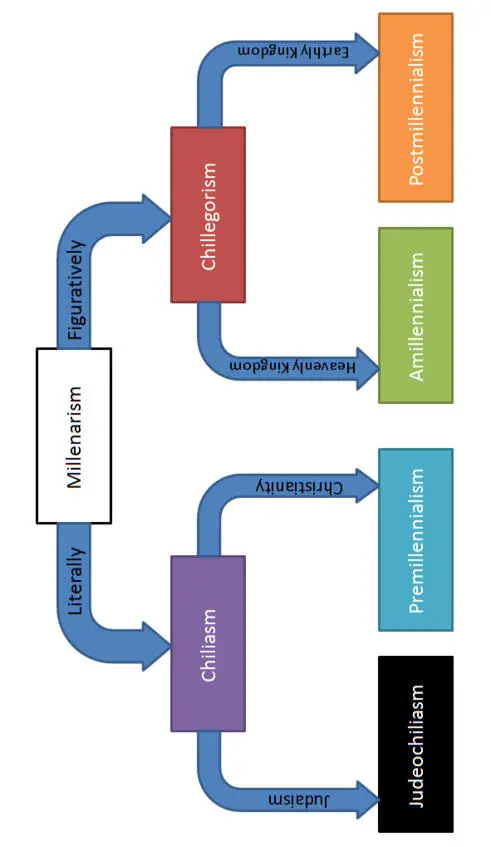
Section 2. Background
Premillenarism as a doctrine was developed after the wide dissemination of the book of Revelation (The Apocalypse) which talks about the future millennial reign of the righteous. This doctrine can also be found in other canonical books of the Bible, though in a less clear way (See Section 6a).
In early Christian sources, Premillenarism appears as ideas about a separate resurrection of the saints (Didache, St. Clement of Rome, St. Ignatius the God-Bearer, St. Polycarp of Smyrna), a thousand-year Sabbath or a time of peace for the righteous (St. Barnabas, St. Justin the Philosopher and Martyr), the transformation of nature that happens in this time (St. Barnabas, St. Papias of Hierapolis). A highly detailed exposition of the patristic version of Premillenarism is found in “Against Heresies” by St. Irenaeus of Lyons.
Premillenarism was also supported by the Apostle Hermas, Clement of Alexandria, bishop Nepos of Egypt, Tertullian, St. Hippolytus of Rome, Commodian of Gaza, St. Victorinus of Petava, St. Athanasius the Great, St. Methodius of Patara and Olympus, Lucius Lactantius, St. Sulpicius Severus (presumably), St. Aurelius Augustine of Hippo (in his early works, later he leaned towards Chillegorism).
Premillenarism was opposed by the heresy of Hymenaeus and Alexander Philetus (who interpreted the resurrection allegorically [2 Tim 2: 16—18; 1 Tim 1:18—20]) as well as by the heresy of the Ebionites (Judeochiliasm), the heresy of Marcion (who taught about the resurrection of souls), the heresy of the Alogi (who rejected the books of the Apostle John), the heresy of Origen (taught about pre-existence and evolution of souls), the heresy of Marcellus of Ancyra (one of the founders of Postmillenarism), the heresy of Apollinaris of Laodicea (opposed by St. Basil the Great, St. Gregory the Theologian, St. Epiphanius of Cyprus who accused him of Judeochilasm).
The above-mentioned heresy of the Alogi even influenced the books which were included in the canon of the Holy Scriptures – some Christians, following their deception, even questioned the apostolic origins of the Apocalypse (Gaius of Rome, St. Dionysius of Alexandria, Eusebius Pamphilius of Caesarea), and as a result, the book of Revelation became part of the canon with much delay.
Over time, the heresies of Hymenaeus and Alexander Philetus and the heresy of Marcion were transformed into Chillegorism of the Alexandrian school (probably under the influence of Origen). This tendency was severely criticized by the bishop Nepos of Egypt in his book “Refutation of the Allegorists” [“Denunciation of the Lovers of Allegory”]. However, this new teaching found favor with those who had rejected the apostolic origins of the Apocalypse, namely Gaius of Rome, St. Dionysius of Alexandria, Eusebius Pamphilus of Caesarea.
From the 4th century on, when Christians were no longer persecuted in the Roman Empire, the teachings of Gaius of Rome on the “restraining of Satan” (Rev 20:2) became popular among some theologians. This is when Chillegorism took its final form. The following people took an active part in this process: Ephrem the Syrian, St. Philastrius of Brescia, Tychonius Africanus, St. Jerome of Stridon, St. Aurelius Augustine of Hippo, Theodoret of Cyprus. Later, Chillegorism made its way into the widespread “Interpretation of the Apocalypse” by Andreas of Caesarea, which further popularized this teaching.
In the Russian Orthodox theology, Chillegorism was popularized by the metropolitan Macarius Bulgakov in his textbook “The Dogmatic Teaching of the Orthodox Church”. This textbook (more precisely, the Chillegorism it taught) was harshly and most vehemently criticized by the priest Boris Kiryanov in his book “The Complete Explanation of the Earthly Millennial Kingdom of our Lord”.
Section 3. The chronological aspects of the problem
Chronological considerations left their mark on both Chiliasm and Chillegorism.
The Apostle Barnabas suggested that the Second coming of Christ would happen 6000 years after the creation of the world. After that, the resurrection of the chosen righteous would take place – the first resurrection [Rev 20:5]. After that comes the Millennium of peace [Rev 20:6]. He based this opinion on the correlation between the seven days of creation and the literal interpretation of the Biblical statement about the day of the Lord being like a 1000 years [Gen 1:1—2:3; Ps 90:4 (Ps 89:5 rus); 2 Pet 3:8]. The Old Testament promise of the seventh day, the Sabbath [Ex 20:8; Deut 5:12; Ps 24:3—4 (Ps 23:3—4 rus); Jer 17:24—25], was interpreted as a prophecy of the millennial Kingdom (Epistle of Barnabas, chapter 15).
St. Justin the Philosopher and Martyr also supported this view by adding his interpretation of the verse from Isaiah “the days of My people, the works of their hands, will be like unto the days of the tree of life” [Is 65:17—25] as well as his reckoning of God’s promise about Adam dying on the day of eating of the tree of the knowledge of good and evil [Gen 2:17] – Adam was not 1000 years old when he died (Conversation with Triphon, the Jew, 81).
This opinion is shared by St. Irenaeus of Lyons (Against Heresies, 5, 28, 2—3), Hippolytus of Rome (Commentary on the book of Daniel, 4, 23—24; Chronicle), Commodian of Gaza (Carmen apologeticum adversus judaeos et gentes), St. Methodius of Patara and Olympus (The Feast of the Ten Virgins, Discourse 9, Tisiana, chapter 1 and 5), Lucius Lactantius (The Divine Institutes, VII, 14).
The same position was held by Andreas of Caesarea who quoted St. Hippolytus of Rome (Commentary on the Apocalypse, chapters 28, 54, 63).
The idea was that at the end of the seventh millennium, the universal resurrection of the remaining righteous and all sinners would take place corresponding to the eighth day – the day of the resurrection: “For all our care about a virtuous living is looking forward to the future, to the age to come, the onset of which, following the cessation of the sensual time which runs in cycles of weeks and days, is called the eighth day. That is why the superscription: According to sheminith [Ps 12 (Ps 11 rus)] is advice to look beyond the present times to the eighth day. For when this transient and fleeting time, in which one comes to life and another one is destroyed, when there is no more need of coming into being and nothing destructible due to the transformation of our nature to another state of being through the resurrection that we hope for, and when this temporary time ceases to exist because there is no longer a force that brings to life and destroys – then, undoubtedly, these time-measuring seven days will come to an end. And the eighth day will be ushered, that is, the age to come, entirely composed of one day, even as one of the prophets predicts by calling the future life ‘a great day’ [Joel 2:11], since this day will not be illuminated by the sensual Sun but by the true Light, the sun of righteousness, which the prophecy calls the ‘east’ [Zech 6:12] because it never sets in the west” (St. Gregory of Nyssa “The Superscriptions of the Psalms”, book 2, chapter 5).
Читать дальшеИнтервал:
Закладка:
Похожие книги на «Apocalypse. Millennium. Chiliasm and Chillegorism»
Представляем Вашему вниманию похожие книги на «Apocalypse. Millennium. Chiliasm and Chillegorism» списком для выбора. Мы отобрали схожую по названию и смыслу литературу в надежде предоставить читателям больше вариантов отыскать новые, интересные, ещё непрочитанные произведения.
Обсуждение, отзывы о книге «Apocalypse. Millennium. Chiliasm and Chillegorism» и просто собственные мнения читателей. Оставьте ваши комментарии, напишите, что Вы думаете о произведении, его смысле или главных героях. Укажите что конкретно понравилось, а что нет, и почему Вы так считаете.
